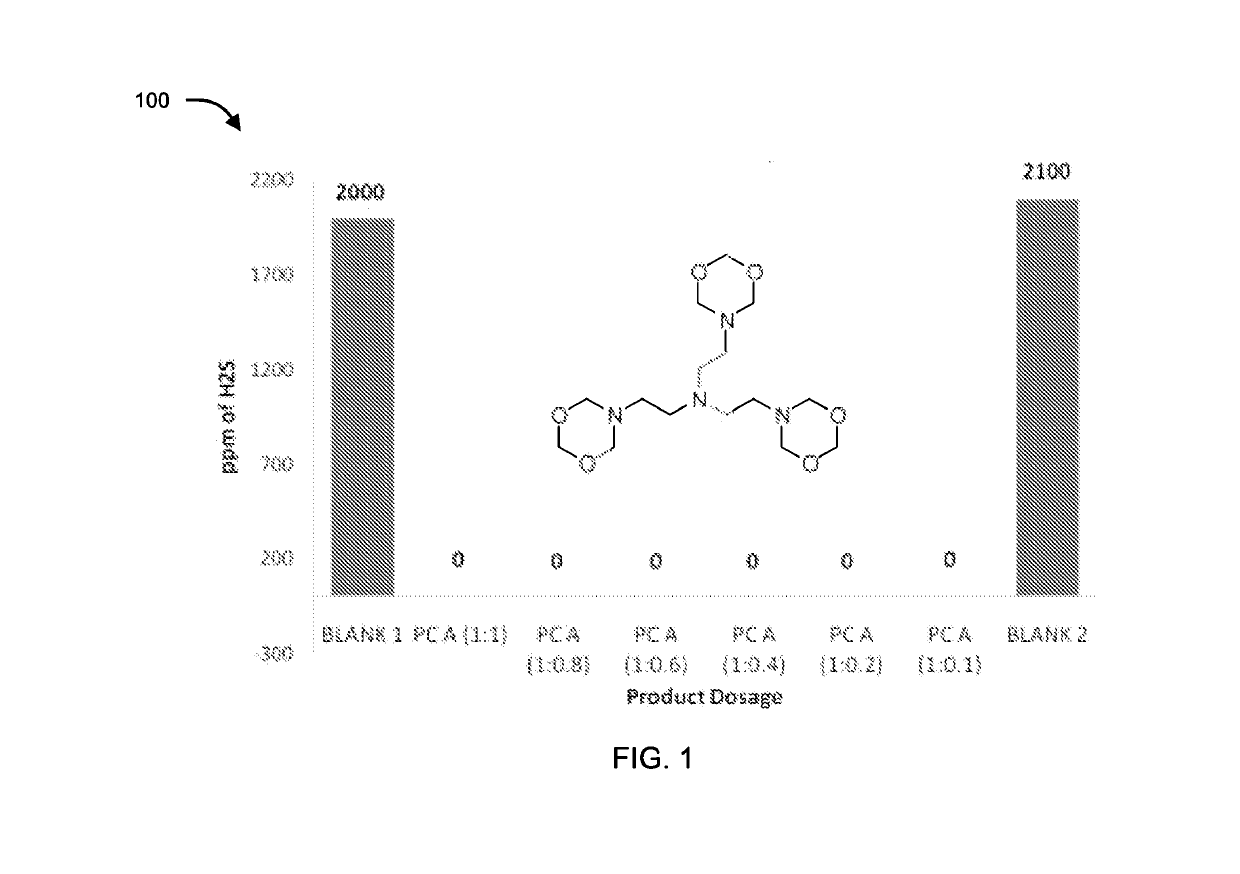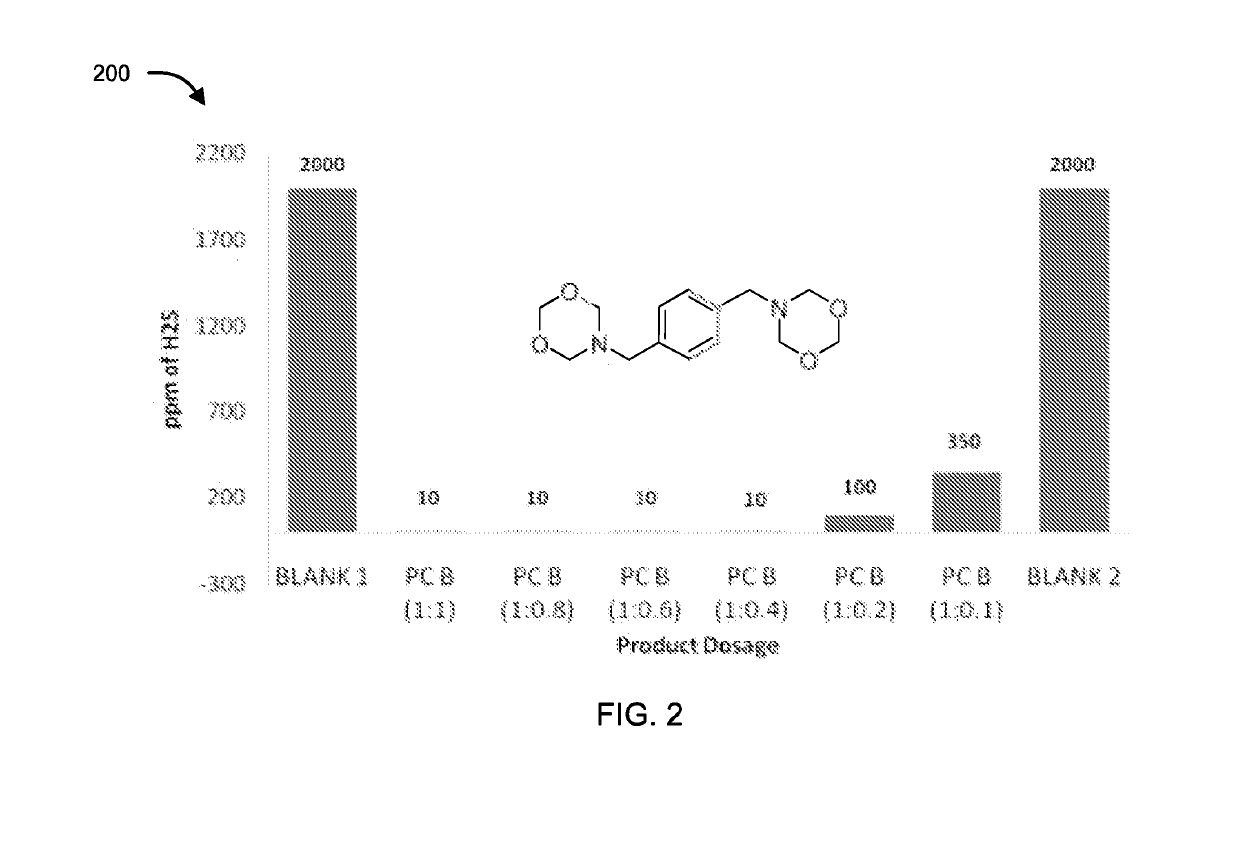1,3, 5-Dioxazine Derivatives, Method of Preparation and Application Thereof as Sulfide Scavenger
- Summary
- Abstract
- Description
- Claims
- Application Information
AI Technical Summary
Benefits of technology
Problems solved by technology
Method used
Image
Examples
example 1
on of tris(2-(1,3,5-dioxazinan-5-yl)ethyl)amine using 37% Aqueous Formalin
[0071]20 Lit pilot scale glass reactor, attached with condenser, thermometer and mechanical stirrer, was charged with, 1462 gm of N,N-Bis(2-aminoethyl)ethane-1,2-diamine and stirred at 5-10° C. till it achieves the bath temperature. 8100 gm, of 37% aqueous formaldehyde, previously cooled at 0° C. was charged through dropping funnel over the period of 2-4 hours. Aqueous formaldehyde being used can have the concentration ranging from 5-50%. The process comprising admixing amine and aqueous formaldehyde was carried out at temperature ranging from 0-20° C., preferably between 0-5° C. Slight exotherm was observed during initial addition of formaldehyde to amine, from 5° C. to 40° C., which can be controlled using external cooling to the reactor. In the reaction between amine and formaldehyde, amine to formaldehyde ratio for one NH2 group is 3-6. After complete addition of the formaldehyde solution, reaction mixture...
example 2
on of tris(2-(1,3,5-dioxazinan-5-yl)ethyl)amine using paraformaldehyde
[0072]10 Lit pilot scale glass reactor, attached with condenser, thermometer and mechanical stirrer, was charged with, 1462 gm of N,N-Bis(2-aminoethyl)ethane-1,2-diamine followed by addition of 5538 gm of water and stirring at 5-10° C. till it achieves the bath temperature. 3000 gm, of Paraformaldehyde, was added portion wise over the period of 4 hours. Slight exotherm was observed during initial addition of Paraformaldehyde to amine, from 5° C. to 40° C., which can be controlled using external cooling to the reactor. After complete addition of the Paraformaldehyde, reaction mixture was allowed to stir at room temperature over 15 hours. Excess formaldehyde from the product was removed by distillation of the reaction mixture under reduced pressure, which affords thick orange colored compound free of excess formalin. This step of distilling was carried out at reduced pressure at 10-80° C., and more specifically at 4...
example 3
Sulfide Scavenging Capacity Test
[0073]The compounds of formula II, III, IV, V and VI were tested for their application as hydrogen sulfide scavenger using ASTM D5705 test method. ASTM D5705 is a Standard Test Method for Measurement of Hydrogen Sulfide in the Vapor Phase above Residual Fuel Oils. In typical testing, Exxsol D80 solvent was used as test solvent which was saturated with hydrogen sulfide gas with specified pressure and time in glass bottles. H2S saturated Exxsol D80 was closed properly and allowed to stand at 60° C. for 2 hours. Vapour phase H2S was measured using Dragger Tube fixed inside rubber cork at one end and a pump at other end, to effectively suck all the vapour phase H2S. Similarly, for testing the performance of the compounds, after saturation step different dosages of chemicals under discussion were added before closing the bottle. Typical dosages of the compounds with respect to concentration of H2S (observed in blank) were 1:1, 1:0.8, 1:0.6, 1:0.4, 1:0.2 an...
PUM
 Login to View More
Login to View More Abstract
Description
Claims
Application Information
 Login to View More
Login to View More - R&D
- Intellectual Property
- Life Sciences
- Materials
- Tech Scout
- Unparalleled Data Quality
- Higher Quality Content
- 60% Fewer Hallucinations
Browse by: Latest US Patents, China's latest patents, Technical Efficacy Thesaurus, Application Domain, Technology Topic, Popular Technical Reports.
© 2025 PatSnap. All rights reserved.Legal|Privacy policy|Modern Slavery Act Transparency Statement|Sitemap|About US| Contact US: help@patsnap.com



